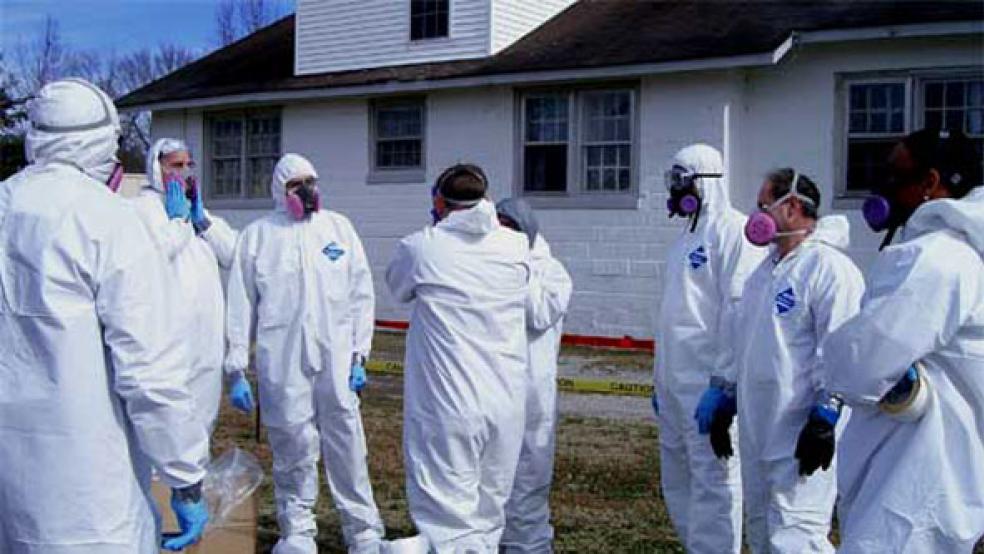New environmental regulation aimed at preventing lead poisoning in children during home remodeling is causing uproar. Not because people are insensitive to the more than one million children who may suffer brain damage from high exposure to lead paint — but because the law is so strict, so burdensome, that many small businesses and home owners can’t afford the extra costs to meet the standards. The Environmental Protection Agency rule which was implemented last month requires any renovations on homes built before 1978 to be completed by certified contractors who follow a stringent set of lead-safe practices.
The remodeling construction industry considers the new Renovation, Repair and Painting (RRP) rule to be a “game changer.” Here’s why: Under the new regulations designed to minimize and contain dust, contractors will be required to perform a lead-safety test on the home, wearing protective clothing with a respirator that looks like something out of Star Trek, and covering up the workspace with thick layers of plastic. In addition they must complete an EPA training course. To top it off, violators will have to pay a fine of up to $37,500 a day. According to the EPA, lead paint was used in 38 million homes before it was banned in 1978.
“It will be very difficult to survive this blow,” said Kathy Faia, a contractor from Kenner, Louisiana. “Remodeling is going to be a very expensive proposition going forward . . . If I had the past two years to do over again, I would have gotten out of remodeling while the getting was good.”
This rule is an example of the unintended consequences of a government action that could have a devastating economic impact on millions of property owners and small businesses amid one of the worst recessions in modern history.
The EPA Punch List
Getting trained is the easy part. That will cost $300 for a one-day class with a 20-question exam, with certification good for five years. As of mid-May, about 256,000 remodelers have obtained the certification. It’s the higher labor costs and extra time to complete a remodeling job that could prove lethal for small business owners whose livelihoods depend on home improvements.
The construction industry has been struggling to stay afloat during the recession and only recently began digging out of a very deep hole. The remodeling industry expects to see a 5 percent increase in revenue this year — its first growth since 2006. The new regulations will add seven to 15 percent to the cost of a basic home improvement or renovation, according to industry experts. The added layer of costly regulations to contractors is passed on to homeowners, who are likely to think twice about giving their bathroom a face-lift .
While individual projects vary, contractors will essentially have to put a plastic tent over the entire house for a simple window replacement and tack on an additional $35 to $110 per window, said Sal Alfano, editorial director at Remodeling magazine.
EPA officials say some of the industry figures are exaggerating the impact of the new regulation. They estimate the cost to contractors will range from $8 to $167 per job, “with the exception of some exterior jobs.” The EPA said these costs were based on “extensive economic analyses, which show that the requirements of the rule are not excessive or overly burdensome,” said Dale Kemery, EPA spokesman.
Gotcha!
Contractors and homeowners alike have been startled by the federal fine of up to $37,500 per day, per violation, for violating the law. But the EPA might have to rely on a nosy neighbor to finger the violator since the EPA has minimal enforcement procedures. Only 40 EPA employees nationwide been assigned to oversee all lead-related issues. The agency hopes to rely on tips and complaints through the 1-800-424-LEAD hotline, said Kemery. “For me, one day of fines and I’m out of business,” said Kathy Faia, owner of Faia Construction, Inc. “That’s the difference between life and death for me.” Faia, 62, and her husband started their remodeling business 31 years ago, specializing in kitchens and baths. They are among a small percentage of remodeling firms that already follow lead-safe practices.
Faia said she hasn’t received any job bids since her company completed the EPA training. With Faia’s business already suffering a 50 percent revenue decline since 2008, she is afraid potential clients are hiring illegitimate, uncertified contractors who can offer lower prices. Some homeowners may resort to do-it-yourself practices, since they aren’t covered under the law.
Other certified contractors have also reported that they are receiving fewer job bids. Phil Vanderloo, President of Hiline Builders in Fair Oaks, California has been remodeling residential homes for 30 years. After factoring in the higher costs — which put him above other contractors — Vanderloo now lands about 20 percent of all the jobs he bids on, compared to 50 or 60 percent before. “It will hurt the small honest practitioner who wants to do the right thing,” Alfano said. “They will all feel the pinch. Unfortunately the ones who have the most integrity will feel it the most.”
Of course, not all remodelers are running out to get certified or buy EPA-mandated equipment, including a HEPA vacuum, which traps fine dust particles and can run up to $2,500. Williams is a self-employed plumber who refuses to get certified. “The impact is huge all over,” Williams said. “The lead problem is a serious problem for sure but to circle out lead-paint as the only problem and have all contractors abide by it is too costly.” Critics say the EPA fails to effectively address the lead poisoning issue and instead causes more headaches for contractors and home owners. In an industry comprised primarily of sole proprietors, losing more job bids on top of the already sluggish housing market could drive contractors to join a growing underground remodeling community.
Shawn McCadden an industry consultant and former remodeler in Massachusetts, recently spoke to a group of contractors about the new rule. Many contractors asked McCadden how they could hide from the EPA and only a few said they would report illegal activity. “Those that are going [to the class] are crawling,” McCadden said. “A lot of contractors are upset about this and they don’t want to do it.”
Please let us know what you think of this article, using the comments box below.
Related Links:
Lead Poisoning Still a Threat as New Rules Takes Effect (AOL News)
Rule on Lead Safety Set to Take Effect (New York Times)
The Mayo Clinic’s Leading Poisoning Info Page





